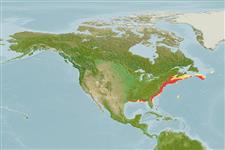Environment: milieu / climate zone / depth range / distribution range
Ecology
Marine; brackish; demersal; depth range 10 - 183 m (Ref. 5951). Temperate; 54°N - 29°N
Western Atlantic: Newfoundland in Canada to northeastern Florida in USA.
Size / Weight / Age
Maturity: Lm ? range ? - ? cm
Max length : 36.0 cm TL male/unsexed; (Ref. 7251); common length : 20.0 cm TL male/unsexed; (Ref. 3821)
Dorsal spines (total): 0; Dorsal soft rays (total): 8; Anal spines: 0; Anal soft rays: 7. Upper side grey or brown with poorly defined black spots and saddles. Belly yellow to white. Tiny jet-black pepper spots (about 1 mm in diameter) scattered over most of pigmented surface, particularly evident on cheeks. Lower sides with a row of black, elongate, bar-like markings. No lappets on head or body (Ref 53033).
Inhabits bays, estuaries and protected coastal waters. Sold as `sea squab' in northern part of range. Feeds primarily on shellfish, occasionally on finfish. Reportedly non-toxic.
Life cycle and mating behavior
Maturity | Reproduction | Spawning | Eggs | Fecundity | Larvae
Robins, C.R. and G.C. Ray, 1986. A field guide to Atlantic coast fishes of North America. Houghton Mifflin Company, Boston, U.S.A. 354 p. (Ref. 7251)
IUCN Red List Status (Ref. 130435: Version 2024-1)
Threat to humans
Harmless
Human uses
Fisheries: minor commercial; aquarium: commercial
Tools
Special reports
Download XML
Internet sources
Estimates based on models
Preferred temperature (Ref.
123201): 4.9 - 24.4, mean 9.3 °C (based on 71 cells).
Phylogenetic diversity index (Ref.
82804): PD
50 = 0.5000 [Uniqueness, from 0.5 = low to 2.0 = high].
Bayesian length-weight: a=0.02291 (0.01031 - 0.05092), b=2.89 (2.72 - 3.06), in cm total length, based on LWR estimates for this Genus-body shape (Ref.
93245).
Trophic level (Ref.
69278): 4.0 ±0.66 se; based on food items.
Resilience (Ref.
120179): High, minimum population doubling time less than 15 months (K=0.6).
Fishing Vulnerability (Ref.
59153): Low vulnerability (24 of 100).
Climate Vulnerability (Ref.
125649): Low vulnerability (22 of 100).
Nutrients (Ref.
124155): Calcium = 38.7 [16.1, 97.2] mg/100g; Iron = 0.415 [0.167, 0.986] mg/100g; Protein = 18.3 [16.1, 20.6] %; Omega3 = 0.641 [0.299, 1.355] g/100g; Selenium = 15.5 [6.7, 35.4] μg/100g; VitaminA = 7.65 [2.05, 30.83] μg/100g; Zinc = 0.49 [0.34, 0.77] mg/100g (wet weight);
